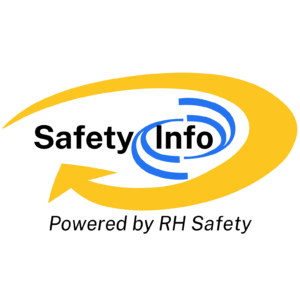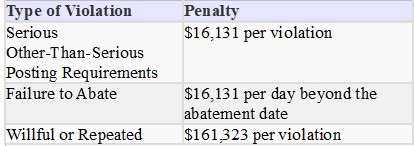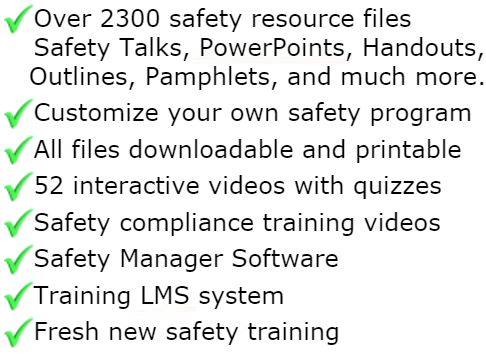
What is Safety & Safety Programs
What is Safety?
If you ask ten people in your company, "What is Safety?" and get ten different answers, you may have identified a basic problem in the management of your safety programs. Ask about your company Quality Control or Production programs and you will most likely get a consensus answer - everyone probably understands and accepts these programs at the same basic level. The same applies to accounting practices - there are well defined and accepted standards and procedures used to measure production activity.
The first, most basic step in any process in to get everyone on the same page. Employees must be able to identify and understand the following three facets of your safety program:
1. what is the safety program
2. what are the safety program goals
3. what is expected
What is the safety program?
Simply put "Safety" is a management tool used to:
- identify, eliminate and manage risks
- develop safety standards
- respond to accidents & injuries
- train employees in expected behaviors & standards
- monitor compliance, conditions & behaviors
- document compliance
- set goals for action and improvement
What are safety program goals?
As with any goal, there must be a clear purpose. In addition, you must be able to tell where you are, at any one time, in relation to the desired endpoint. To communicate and achieve goals they must be:
• written
• measurable
• well defined
• achievable
• challenging
• assigned
Goals must be written - if you don't publish safety goals, you cannot expect others to work towards their achievement. Written goals must include how they are to be measured (including milestones). The must be well defined and simple to understand. Additionally, they should be written in a manner that conveys that they are achievable as well as challenging, so that there is a constant process of improvement.
Goals must be measurable - simply recording & tracking accidents & injuries is really just measuring the failures of the safety system. Measurements that are effective include the results of and response to safety program tools such as audits, inspections, formal observation and review of records
Goals must be well defined - establishing the "scope" of specific goals is an important factor in allowing management and employees to understand the goal - provide specific endpoints that define the accomplishment of the goal - keep the language of the goal short, simple, and easy to understand.
Goals must be achievable - setting a goal of ZERO accidents may sound like an excellent goal and is certainly specific and measurable, however it may not be achievable. When determining the "achievability" of a goal, consider the current conditions and "state" of safety in relation to the goal. Setting goals that are achievable provides a climate of success when goals are met - conversely, if goals are set too high and are not achieved, then frustration, resentment and failure are injected into the company safety culture.
Goals must be challenging - setting goals that are easily achieved may take effort out of compliance, but will often cause decay of involvement and monitoring. Every survey ever taken concerning employee job satisfaction lists a "challenging work environment" at or near the top of the list of employee desires. Be careful not to confuse making challenging goals with making the safety process harder.
Goals must be assigned - who is involved in meeting safety goals must be defined. Defining what part each person plays - and what their specific activities are must be communicated in the written goal to avoid the "that's not my job" response."
EXAMPLES of a safety goal
Equipment Training: Within the next sixty days, train all shipping & receiving employees in the proper use and safe operation of material handling equipment. Training will be:
• in accordance with the written program guidelines
• conducted both in a classroom setting and at the worksite
• conducted by the shipping manager and supervisors
• recorded on the proper safety program forms
Accident Investigations: All accidents and injuries will be investigated by the area supervisor as soon as immediate hazards have been controlled and any medical assistance provided. The initial supervisor findings, observations and immediate corrective actions will be provided to the area manager within two hours of the start of the investigation and in any case not latter than the end of the shift. Management will review and assign permanent corrective actions within 24 hours of the accident.
What is expected?
One of the significant benefits of having written safety programs is that it acts as a vehicle for establishing the safety roles and standards for management, supervisors and employees.
Setting and communicating standards is not an easy task, especially considering that safety standards are a compliance issue dictated by OSHA regulations, many of which border on epic proportions. It is the job of management to distill these government regulations into easily understood and remembered behaviors. Management must also develop specific tools to train employees, monitor activity and document compliance - all this without over-burdening the production, maintenance and quality control efforts. Communicating safety standards starts day one with the new employee by having them participate in a safety orientation class and continues with periodic specific training that applies to their job and assigned tasks. Other tools for communicating standards and expectations are company newsletters, posters, immediate on-the job positive correction of unsafe behaviors, safety information pamphlets and informal safety talks by supervisors. Standards that define the periodic evaluation of employee compliance and program management is essential for gathering information on which to base needed changes in standards and procedures. Audits, inspections and task completion documents - such as training forms - should be simple to follow and to complete. Employee actions that violate established standards or policies must be addressed immediately to determine the reason for deviation. Punitive responses should be reserved only for the most serious infractions. Taking an honest look at most infractions will show that the real root cause is the failure to either properly train employees, monitor activates or set effective standards.
If you want your safety program to be effective, all employees must know the program, goals and their part. And finally, set realistic and effective goals.

GET INSTANT ACCESS
to THE MEMBERS LIBRARY
Safety materials created by safety professionals.
Access to the Safety Manager software.
Wide variety of safety videos and courses.
**Brand New** Safety Training Management System
Pre-Made Safety Materials Ready For Use
Created by experienced safety professionals & risk consultants. Saving you time, money, and risk of injuries.
95% of the work already done.
Below are the maximum penalty amounts, with the annual adjustment for inflation, that may be assessed after Jan. 15, 2024. (See OSHA Memo, Jan. 8, 2024).

**New OSHA HEAT 90 DAY**
>>Download Free HERE<<
**New 2024 OSHA 300 Form**
>>Download Free HERE<<
**Brand New**
Free with full membership subscription
Training LMS System
Ask The Safety Consultant
Safety Equipment Deal Finder

“SafetyInfo.com is the first go-to website for safety professionals and companies to use in establishing a solid safety program"
-Mike McKenzie, Certified Safety & Health Manager (CSHM), McSafety Solutions™
Note: You must have a full subscription to the Safety Library in order to use this material. Any use outside of your organization, for resell, or without an active membership is strictly prohibited and may result in prosecution under copyright infringement laws. Please contact us first, if you would be interested in reselling or using our materials for reproduction.
Inside the Members Library
Topic Index
Accident Prevention
Air Quality
Asbestos
Bloodborne Pathogens
Boilers
Chemical Safety
Compressed Gas
Confined Space
Construction
Construction Worksite
Cranes & Slings
Driver / Fleet Safety
Drug Free Workplace
Electrical
Emergency Management
Engineering Safety
Environmental
Equipment
Ergonomics
Fall Protection
Fire Safety & Prevention
First Aid
Flammable Materials
Forklifts
Hazard Communication
Hazardous Materials
Hearing Protection
Heat Stress
Hot Work
Housekeeping
Job Safety Analysis
Laboratory
Ladders
Lead
Lockout-Tagout
Machinery & Equipment
Material Handling
MSDS (SDS)
Medical & First Aid
Occupational Health
Office Safety
Off the Job Safety
Personal Protection
Process Safety
Record Keeping
Respiratory Protection
Silica Safety
Rules & Policies
Signs & Labels
Slips, Trips & Fall
Training
Terrorism Programs
Tool Safety
Vehicle & Driver
Violence Programs
Welding & Hot Work
Training Videos
Library Index
Training Materials
Videos/Courses
Talks
Articles
PowerPoint
Handouts
Training Overheads
Quizzes
Supervisor Briefs
Management Briefs
Safety Sessions
2 Minute OSHA Safety Talks
Pamphlets
First Aid Training
Supervisor Training
Hazardous Materials
Bomb Threat
Crossword Puzzles
Biological Agents
Forms & Documents
Forms
Checklists
Audit Guides
Inspections Guides
Signs & Labels
Environmental Audit Guides
Recordkeeping - OSHA 300
Sign & Label Maker
Safety Management Resources
Safety Manuals/Written Programs
Ergonomic Programs
Emergency Plans
Process Safety Management
Construction Safety
Occupational Health
Environmental
Topic Sheets
DOT Fleet-Driver
Hazardous Materials
Chemical Safety
Drug Free Workplace
Terrorism Programs
Development Guides
Safety Manager Software
Safety References & Graphics
Technical Safety Information
Posters
Topic & Fact Sheets
Development Information
Job Specific Safety Rules
Terrorism
Calculators
Safety Comic Strips
New Safety Training System
Schedule and train your employees with our materials. Add unlimited amount of employees. Record all progress and issue certificates. For group and individual training sessions.

